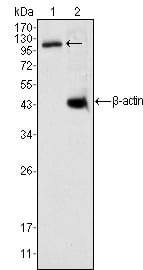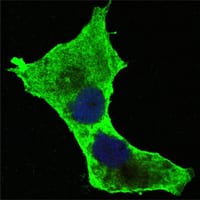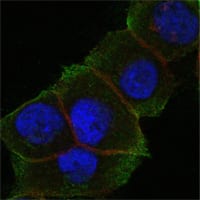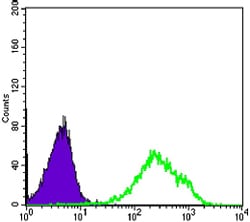



| WB | 1/500 - 1/2000 | Human,Mouse,Rat |
| IF | 咨询技术 | Human,Mouse,Rat |
| IHC | 咨询技术 | Human,Mouse,Rat |
| ICC | 1/200 - 1/1000 | Human,Mouse,Rat |
| FCM | 1/200 - 1/400 | Human,Mouse,Rat |
| Elisa | 1/10000 | Human,Mouse,Rat |
| Aliases | DAP6; EAP1; BING2 |
| Entrez GeneID | 1616 |
| clone | 7A11 |
| WB Predicted band size | 81kDa |
| Host/Isotype | Mouse IgG1 |
| Antibody Type | Primary antibody |
| Storage | Store at 4°C short term. Aliquot and store at -20°C long term. Avoid freeze/thaw cycles. |
| Species Reactivity | Human |
| Immunogen | Purified recombinant fragment of human DAXX expressed in E. Coli. |
| Formulation | Purified antibody in PBS with 0.05% sodium azide. |
+ +
以下是3篇关于DAXX抗体的参考文献,涵盖不同研究方向和实验应用:
---
### 1. **"DAXX/ATRX complex recognizes a chromatin switch to regulate cell fate in pancreatic neuroendocrine tumors"**
**作者**: Heaphy CM, et al.
**摘要**:该研究使用DAXX抗体(克隆号:H-7)通过免疫组织化学(IHC)分析胰腺神经内分泌肿瘤(PanNETs)中DAXX蛋白的缺失情况,发现DAXX/ATRX复合物通过染色质重塑调控细胞分化,其缺失与肿瘤恶性程度和患者预后相关。
---
### 2. **"Immunohistochemical detection of DAXX and ATRX loss in pancreatic neuroendocrine neoplasms"**
**作者**: Marinoni I, et al.
**摘要**:研究通过DAXX抗体(兔多克隆,Sigma-Aldrich)对胰腺神经内分泌肿瘤样本进行染色,验证DAXX蛋白缺失与基因突变的关联性,提出DAXX免疫组化可作为临床诊断中预测基因组稳定性的生物标志物。
---
### 3. **"DAXX functions as a critical regulator of EZH2-mediated cancer transcriptional programs"**
**作者**: Drane P, et al.
**摘要**:利用DAXX特异性抗体(Cell Signaling Technology #4533)进行ChIP-seq和Western blot分析,揭示了DAXX通过调控EZH2的染色质定位影响癌症相关基因的转录程序,强调其在表观遗传调控中的双重作用。
---
**备注**:以上文献均明确提及使用DAXX抗体进行蛋白表达分析,涵盖肿瘤病理学、分子机制及诊断应用,可作为相关实验的参考依据。
DAXX (Death Domain-Associated Protein 6) is a multifunctional protein involved in diverse cellular processes, including apoptosis, transcriptional regulation, chromatin remodeling, and epigenetic modulation. It interacts with various partners, such as the apoptosis-related FAS receptor, PML nuclear bodies, and the ATRX histone chaperone complex, playing roles in repressing gene expression, mediating histone H3.3 incorporation into heterochromatin, and maintaining genomic stability. DAXX is also implicated in telomere maintenance and viral defense mechanisms.
DAXX antibodies are essential tools for studying its expression, localization, and interactions in research. They are widely used in techniques like Western blotting, immunofluorescence (IF), and immunohistochemistry (IHC) to investigate DAXX's role in cancers (e.g., pancreatic neuroendocrine tumors with ATRX/DAXX mutations), neurodegenerative diseases, and immune responses. Commercially available antibodies target specific epitopes, but validation is critical due to potential cross-reactivity or isoform-specific signals. Aberrant DAXX expression or mutations are linked to altered chromatin dynamics, impaired DNA repair, and tumorigenesis, making it a biomarker of interest in oncology. Researchers also utilize DAXX antibodies to explore its dual role in apoptosis (pro- or anti-apoptotic effects depending on context) and its partnership with ATRX in regulating repetitive genomic regions. Proper antibody selection ensures accurate detection in both nuclear and cytoplasmic compartments, reflecting its dynamic subcellular distribution under stress or disease conditions.
×